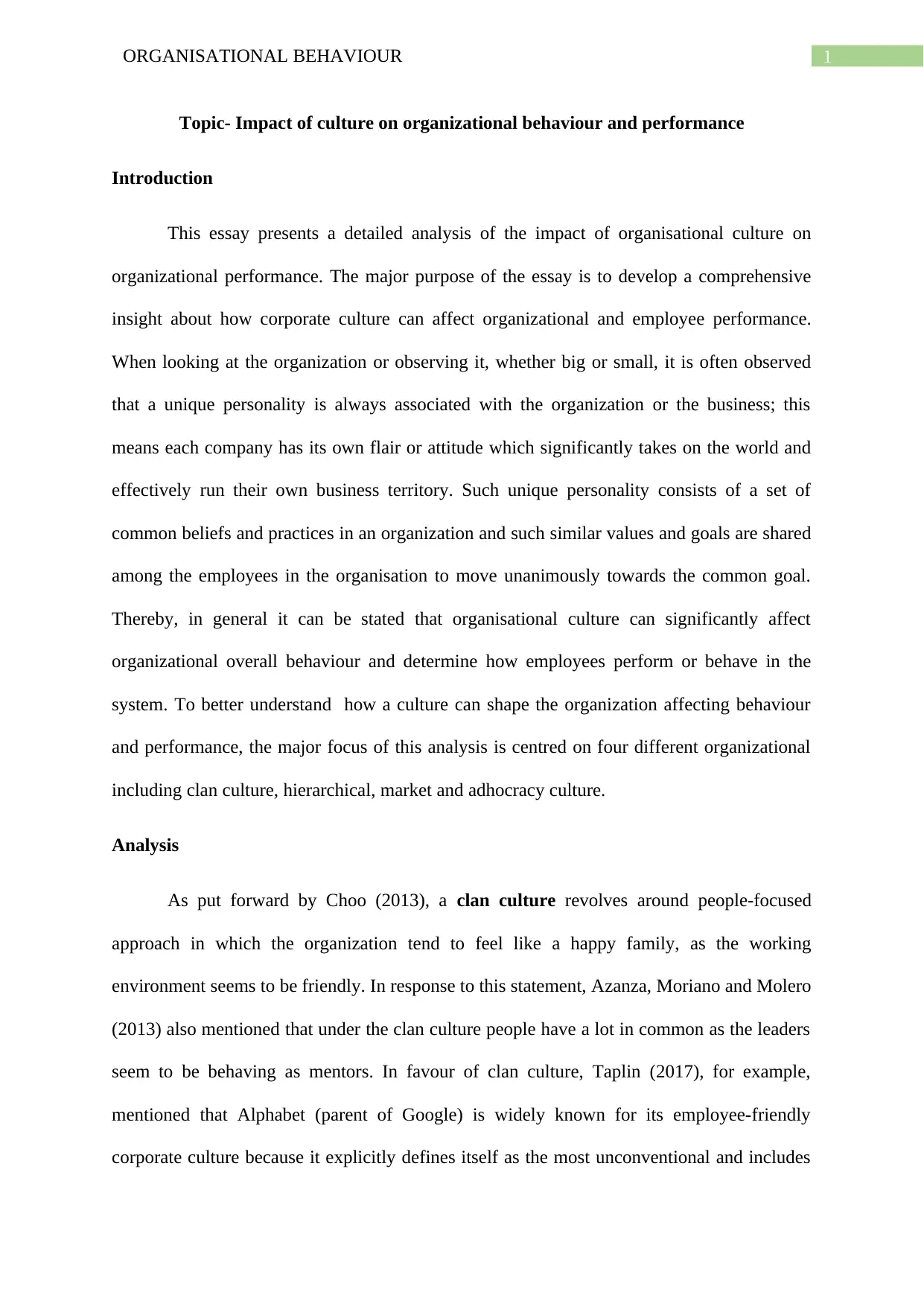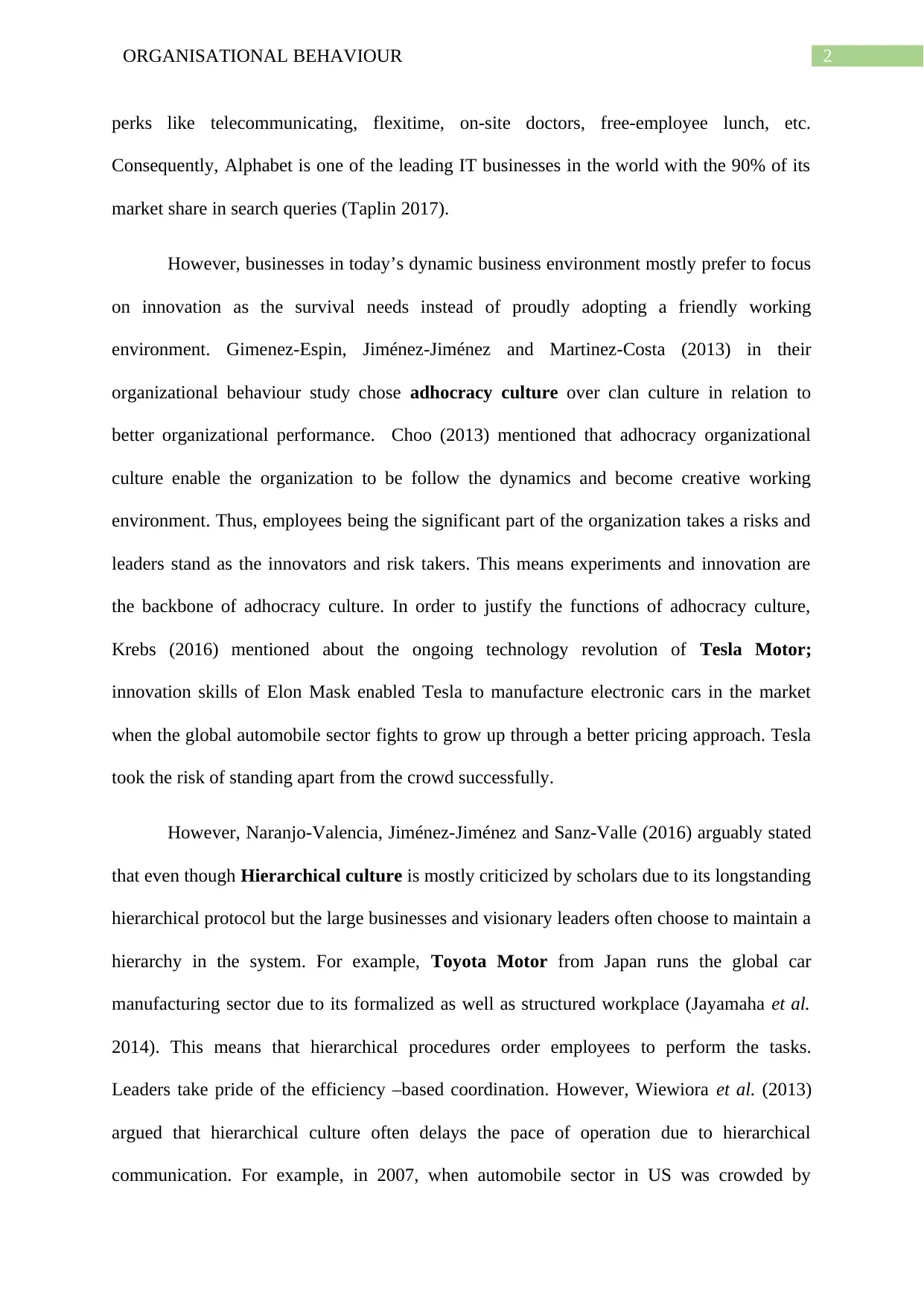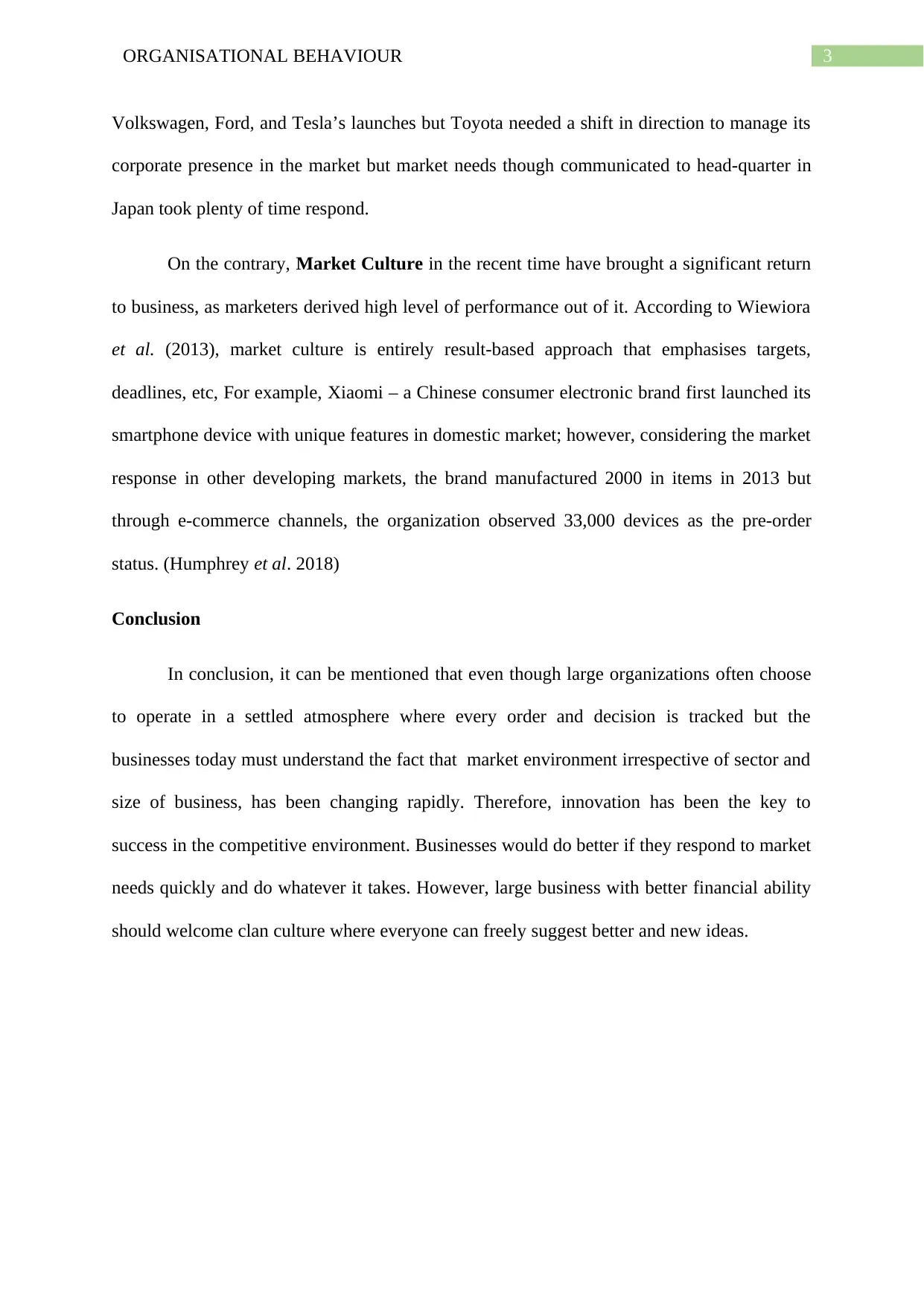Organisational Behaviour - an overview | Science
VerifiedAdded on 2022/08/24
|6
|1338
|15
AI Summary
Contribute Materials
Your contribution can guide someone’s learning journey. Share your
documents today.

Running head: ORGANISATIONAL BEHAVIOUR
Organisational Behaviour
Name of the Student
Name of the University
Author Note
Organisational Behaviour
Name of the Student
Name of the University
Author Note
Secure Best Marks with AI Grader
Need help grading? Try our AI Grader for instant feedback on your assignments.

1ORGANISATIONAL BEHAVIOUR
Topic- Impact of culture on organizational behaviour and performance
Introduction
This essay presents a detailed analysis of the impact of organisational culture on
organizational performance. The major purpose of the essay is to develop a comprehensive
insight about how corporate culture can affect organizational and employee performance.
When looking at the organization or observing it, whether big or small, it is often observed
that a unique personality is always associated with the organization or the business; this
means each company has its own flair or attitude which significantly takes on the world and
effectively run their own business territory. Such unique personality consists of a set of
common beliefs and practices in an organization and such similar values and goals are shared
among the employees in the organisation to move unanimously towards the common goal.
Thereby, in general it can be stated that organisational culture can significantly affect
organizational overall behaviour and determine how employees perform or behave in the
system. To better understand how a culture can shape the organization affecting behaviour
and performance, the major focus of this analysis is centred on four different organizational
including clan culture, hierarchical, market and adhocracy culture.
Analysis
As put forward by Choo (2013), a clan culture revolves around people-focused
approach in which the organization tend to feel like a happy family, as the working
environment seems to be friendly. In response to this statement, Azanza, Moriano and Molero
(2013) also mentioned that under the clan culture people have a lot in common as the leaders
seem to be behaving as mentors. In favour of clan culture, Taplin (2017), for example,
mentioned that Alphabet (parent of Google) is widely known for its employee-friendly
corporate culture because it explicitly defines itself as the most unconventional and includes
Topic- Impact of culture on organizational behaviour and performance
Introduction
This essay presents a detailed analysis of the impact of organisational culture on
organizational performance. The major purpose of the essay is to develop a comprehensive
insight about how corporate culture can affect organizational and employee performance.
When looking at the organization or observing it, whether big or small, it is often observed
that a unique personality is always associated with the organization or the business; this
means each company has its own flair or attitude which significantly takes on the world and
effectively run their own business territory. Such unique personality consists of a set of
common beliefs and practices in an organization and such similar values and goals are shared
among the employees in the organisation to move unanimously towards the common goal.
Thereby, in general it can be stated that organisational culture can significantly affect
organizational overall behaviour and determine how employees perform or behave in the
system. To better understand how a culture can shape the organization affecting behaviour
and performance, the major focus of this analysis is centred on four different organizational
including clan culture, hierarchical, market and adhocracy culture.
Analysis
As put forward by Choo (2013), a clan culture revolves around people-focused
approach in which the organization tend to feel like a happy family, as the working
environment seems to be friendly. In response to this statement, Azanza, Moriano and Molero
(2013) also mentioned that under the clan culture people have a lot in common as the leaders
seem to be behaving as mentors. In favour of clan culture, Taplin (2017), for example,
mentioned that Alphabet (parent of Google) is widely known for its employee-friendly
corporate culture because it explicitly defines itself as the most unconventional and includes

2ORGANISATIONAL BEHAVIOUR
perks like telecommunicating, flexitime, on-site doctors, free-employee lunch, etc.
Consequently, Alphabet is one of the leading IT businesses in the world with the 90% of its
market share in search queries (Taplin 2017).
However, businesses in today’s dynamic business environment mostly prefer to focus
on innovation as the survival needs instead of proudly adopting a friendly working
environment. Gimenez-Espin, Jiménez-Jiménez and Martinez-Costa (2013) in their
organizational behaviour study chose adhocracy culture over clan culture in relation to
better organizational performance. Choo (2013) mentioned that adhocracy organizational
culture enable the organization to be follow the dynamics and become creative working
environment. Thus, employees being the significant part of the organization takes a risks and
leaders stand as the innovators and risk takers. This means experiments and innovation are
the backbone of adhocracy culture. In order to justify the functions of adhocracy culture,
Krebs (2016) mentioned about the ongoing technology revolution of Tesla Motor;
innovation skills of Elon Mask enabled Tesla to manufacture electronic cars in the market
when the global automobile sector fights to grow up through a better pricing approach. Tesla
took the risk of standing apart from the crowd successfully.
However, Naranjo-Valencia, Jiménez-Jiménez and Sanz-Valle (2016) arguably stated
that even though Hierarchical culture is mostly criticized by scholars due to its longstanding
hierarchical protocol but the large businesses and visionary leaders often choose to maintain a
hierarchy in the system. For example, Toyota Motor from Japan runs the global car
manufacturing sector due to its formalized as well as structured workplace (Jayamaha et al.
2014). This means that hierarchical procedures order employees to perform the tasks.
Leaders take pride of the efficiency –based coordination. However, Wiewiora et al. (2013)
argued that hierarchical culture often delays the pace of operation due to hierarchical
communication. For example, in 2007, when automobile sector in US was crowded by
perks like telecommunicating, flexitime, on-site doctors, free-employee lunch, etc.
Consequently, Alphabet is one of the leading IT businesses in the world with the 90% of its
market share in search queries (Taplin 2017).
However, businesses in today’s dynamic business environment mostly prefer to focus
on innovation as the survival needs instead of proudly adopting a friendly working
environment. Gimenez-Espin, Jiménez-Jiménez and Martinez-Costa (2013) in their
organizational behaviour study chose adhocracy culture over clan culture in relation to
better organizational performance. Choo (2013) mentioned that adhocracy organizational
culture enable the organization to be follow the dynamics and become creative working
environment. Thus, employees being the significant part of the organization takes a risks and
leaders stand as the innovators and risk takers. This means experiments and innovation are
the backbone of adhocracy culture. In order to justify the functions of adhocracy culture,
Krebs (2016) mentioned about the ongoing technology revolution of Tesla Motor;
innovation skills of Elon Mask enabled Tesla to manufacture electronic cars in the market
when the global automobile sector fights to grow up through a better pricing approach. Tesla
took the risk of standing apart from the crowd successfully.
However, Naranjo-Valencia, Jiménez-Jiménez and Sanz-Valle (2016) arguably stated
that even though Hierarchical culture is mostly criticized by scholars due to its longstanding
hierarchical protocol but the large businesses and visionary leaders often choose to maintain a
hierarchy in the system. For example, Toyota Motor from Japan runs the global car
manufacturing sector due to its formalized as well as structured workplace (Jayamaha et al.
2014). This means that hierarchical procedures order employees to perform the tasks.
Leaders take pride of the efficiency –based coordination. However, Wiewiora et al. (2013)
argued that hierarchical culture often delays the pace of operation due to hierarchical
communication. For example, in 2007, when automobile sector in US was crowded by

3ORGANISATIONAL BEHAVIOUR
Volkswagen, Ford, and Tesla’s launches but Toyota needed a shift in direction to manage its
corporate presence in the market but market needs though communicated to head-quarter in
Japan took plenty of time respond.
On the contrary, Market Culture in the recent time have brought a significant return
to business, as marketers derived high level of performance out of it. According to Wiewiora
et al. (2013), market culture is entirely result-based approach that emphasises targets,
deadlines, etc, For example, Xiaomi – a Chinese consumer electronic brand first launched its
smartphone device with unique features in domestic market; however, considering the market
response in other developing markets, the brand manufactured 2000 in items in 2013 but
through e-commerce channels, the organization observed 33,000 devices as the pre-order
status. (Humphrey et al. 2018)
Conclusion
In conclusion, it can be mentioned that even though large organizations often choose
to operate in a settled atmosphere where every order and decision is tracked but the
businesses today must understand the fact that market environment irrespective of sector and
size of business, has been changing rapidly. Therefore, innovation has been the key to
success in the competitive environment. Businesses would do better if they respond to market
needs quickly and do whatever it takes. However, large business with better financial ability
should welcome clan culture where everyone can freely suggest better and new ideas.
Volkswagen, Ford, and Tesla’s launches but Toyota needed a shift in direction to manage its
corporate presence in the market but market needs though communicated to head-quarter in
Japan took plenty of time respond.
On the contrary, Market Culture in the recent time have brought a significant return
to business, as marketers derived high level of performance out of it. According to Wiewiora
et al. (2013), market culture is entirely result-based approach that emphasises targets,
deadlines, etc, For example, Xiaomi – a Chinese consumer electronic brand first launched its
smartphone device with unique features in domestic market; however, considering the market
response in other developing markets, the brand manufactured 2000 in items in 2013 but
through e-commerce channels, the organization observed 33,000 devices as the pre-order
status. (Humphrey et al. 2018)
Conclusion
In conclusion, it can be mentioned that even though large organizations often choose
to operate in a settled atmosphere where every order and decision is tracked but the
businesses today must understand the fact that market environment irrespective of sector and
size of business, has been changing rapidly. Therefore, innovation has been the key to
success in the competitive environment. Businesses would do better if they respond to market
needs quickly and do whatever it takes. However, large business with better financial ability
should welcome clan culture where everyone can freely suggest better and new ideas.
Secure Best Marks with AI Grader
Need help grading? Try our AI Grader for instant feedback on your assignments.

4ORGANISATIONAL BEHAVIOUR
References
Azanza, G., Moriano, J.A. and Molero, F., 2013. Authentic leadership and organizational
culture as drivers of employees’ job satisfaction. Revista de Psicología del Trabajo y de las
Organizaciones, 29(2), pp.45-50.
Choo, C.W., 2013. Information culture and organizational effectiveness. International
Journal of Information Management, 33(5), pp.775-779.
Gimenez-Espin, J.A., Jiménez-Jiménez, D. and Martinez-Costa, M., 2013. Organizational
culture for total quality management. Total Quality Management & Business
Excellence, 24(5-6), pp.678-692.
Humphrey, J., Ding, K., Fujita, M., Hioki, S. and Kimura, K., 2018. Platforms, innovation
and capability development in the Chinese domestic market. The European Journal of
Development Research, 30(3), pp.408-423.
Jayamaha, N.P., Wagner, J.P., Grigg, N.P., Campbell-Allen, N.M. and Harvie, W., 2014.
Testing a theoretical model underlying the ‘Toyota Way’–an empirical study involving a
large global sample of Toyota facilities. International Journal of Production
Research, 52(14), pp.4332-4350.
Krebs, S., 2016. Silent by design? Tesla's Model S and the discourse on electric vehicle
sound: Tesla Motors Germany, Model S 85D (2015). Sound Studies, 2(1), pp.93-95.
Naranjo-Valencia, J.C., Jiménez-Jiménez, D. and Sanz-Valle, R., 2016. Studying the links
between organizational culture, innovation, and performance in Spanish companies. Revista
Latinoamericana de Psicología, 48(1), pp.30-41.
Taplin, J., 2017. Move fast and break things: How Facebook, Google, and Amazon have
cornered culture and what it means for all of us. Pan Macmillan.
References
Azanza, G., Moriano, J.A. and Molero, F., 2013. Authentic leadership and organizational
culture as drivers of employees’ job satisfaction. Revista de Psicología del Trabajo y de las
Organizaciones, 29(2), pp.45-50.
Choo, C.W., 2013. Information culture and organizational effectiveness. International
Journal of Information Management, 33(5), pp.775-779.
Gimenez-Espin, J.A., Jiménez-Jiménez, D. and Martinez-Costa, M., 2013. Organizational
culture for total quality management. Total Quality Management & Business
Excellence, 24(5-6), pp.678-692.
Humphrey, J., Ding, K., Fujita, M., Hioki, S. and Kimura, K., 2018. Platforms, innovation
and capability development in the Chinese domestic market. The European Journal of
Development Research, 30(3), pp.408-423.
Jayamaha, N.P., Wagner, J.P., Grigg, N.P., Campbell-Allen, N.M. and Harvie, W., 2014.
Testing a theoretical model underlying the ‘Toyota Way’–an empirical study involving a
large global sample of Toyota facilities. International Journal of Production
Research, 52(14), pp.4332-4350.
Krebs, S., 2016. Silent by design? Tesla's Model S and the discourse on electric vehicle
sound: Tesla Motors Germany, Model S 85D (2015). Sound Studies, 2(1), pp.93-95.
Naranjo-Valencia, J.C., Jiménez-Jiménez, D. and Sanz-Valle, R., 2016. Studying the links
between organizational culture, innovation, and performance in Spanish companies. Revista
Latinoamericana de Psicología, 48(1), pp.30-41.
Taplin, J., 2017. Move fast and break things: How Facebook, Google, and Amazon have
cornered culture and what it means for all of us. Pan Macmillan.

5ORGANISATIONAL BEHAVIOUR
Wiewiora, A., Trigunarsyah, B., Murphy, G. and Coffey, V., 2013. Organizational culture
and willingness to share knowledge: A competing values perspective in Australian
context. International Journal of Project Management, 31(8), pp.1163-1174.
Wiewiora, A., Trigunarsyah, B., Murphy, G. and Coffey, V., 2013. Organizational culture
and willingness to share knowledge: A competing values perspective in Australian
context. International Journal of Project Management, 31(8), pp.1163-1174.
1 out of 6
Related Documents
Your All-in-One AI-Powered Toolkit for Academic Success.
+13062052269
info@desklib.com
Available 24*7 on WhatsApp / Email
![[object Object]](/_next/static/media/star-bottom.7253800d.svg)
Unlock your academic potential
© 2024 | Zucol Services PVT LTD | All rights reserved.




